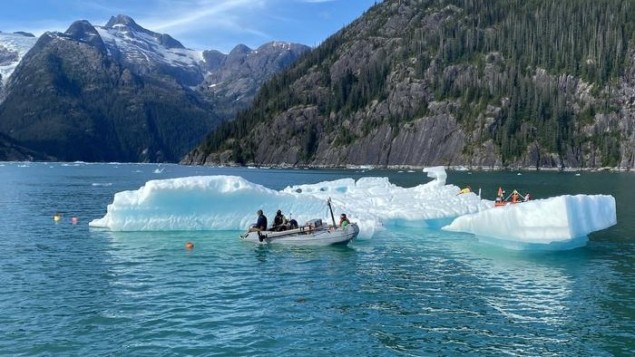
Pressurised bubbles trapped deep inside the ice of tidewater glaciers play an important role in how meltwater is released by these giant structures. That is the conclusion of scientists in the US who were led by Meagan Wengrove at Oregon State University. The team says its findings will help researchers to predict the future melting of glaciers far more accurately than is possible today.
As a result of climate change, many glaciers are in steady retreat. These include tidewater glaciers, which are found at high latitudes where temperatures are cool enough for ice to flow straight into the sea.
Today, glaciologists understand that this loss is being accelerated by feedback between ice melt, glacier flow, and ocean circulation. But even when these effects are incorporated into their models, the calculations consistently underestimate melting rates.
Bursting bubbles
As Wengrove explains, “we believe that there are several important physical mechanisms related to the way tidewater glaciers melt that are missing from these models. One of them could be the bursting and rising of bubbles”. This idea first emerged in 2015, when Erin Pettit, also at Oregon State, observed how glacier melting is impacted by the release of trapped air bubbles.
These bubbles form in the gaps between the snowflakes falling on top of glaciers. These bubbles account for around 10% of the volume of newly formed ice. They then become compressed as fresh snow accumulates, eventually reaching pressures as high as 20 atmospheres as they sink to the bottom of the glacier.
Wengrove explains that this pressure has dramatic effects when the air is finally released: “Pettit found out that once a tidewater glacier reaches the ocean, the ice makes popping sounds as it melts. This is because bubbles encapsulated in the ice explode out into the water, due to a pressure differential between the seawater and the internal bubble pressure.”
Turbulent mixtures
Bubbles are known to have an important influence on how fluids mix together – affecting a range of industrial processes, for example. According to Wengrove, this effect should be no less relevant for glacier melting, which involves the mixing of cold meltwater with warmer seawater. Until now, however, the influence of bubbles on glacier melting had barely been considered.
Building on Pettit’s discovery, Wengrove, Pettit and their colleagues have studied the effect from a multi-disciplinary perspective: covering fields including glaciology, oceanography, and Wengrove’s own speciality of fluid mechanics.
“Our study measured water column velocities and turbulence adjacent to melting real glacier ice, which had never been done before,” Wengrove explains. “We also compared our results to a second set of experiments with clear, bubble-free ice, to mimic how past melt experiments had been performed.“

Trapped in ice: the surprisingly high levels of artificial radioactive isotopes found in glaciers
By including bursting bubbles in their model, the team was able to describe the observed melting of tidewater glaciers far more closely than previous studies. “In a lab setting, we found that glacier ice melts 2.25 times faster than clear bubble-free ice,” says Wengrove. “We also saw that glacier ice produced 20 times more kinetic energy and six times more turbulent kinetic energy than clear ice.”
Based on these observations, the researchers developed a new model that includes the amount of energy the bubbles contribute to the melting process as they burst, then rise to the ocean surface. They also considered how this energy varies with both bubble and water pressure.
Wengrove’s team hope that their work will encourage future studies that will model the melting of tidewater glaciers far more accurately than possible today. If successful, this would provide scientists with important information that could lead to a better understanding of global-scale changes to Earth’s oceans and atmosphere in the coming decades.
The research is described in Nature Geoscience.
- SEO Powered Content & PR Distribution. Get Amplified Today.
- PlatoData.Network Vertical Generative Ai. Empower Yourself. Access Here.
- PlatoAiStream. Web3 Intelligence. Knowledge Amplified. Access Here.
- PlatoESG. Carbon, CleanTech, Energy, Environment, Solar, Waste Management. Access Here.
- PlatoHealth. Biotech and Clinical Trials Intelligence. Access Here.
- Source: https://physicsworld.com/a/bursting-bubbles-accelerate-melting-of-tidewater-glaciers/



